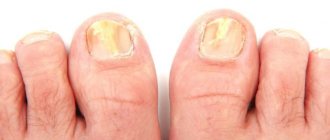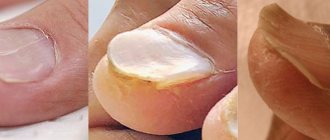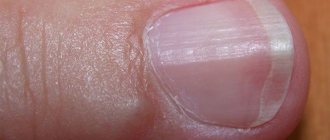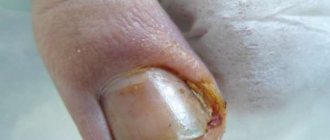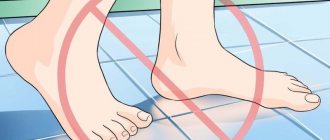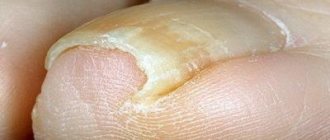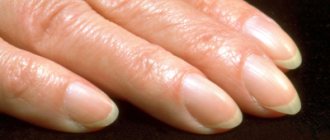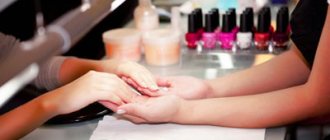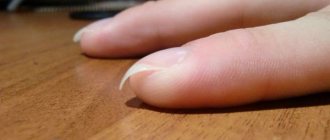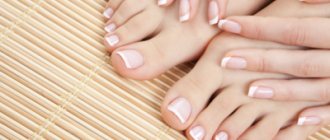Thumb - big problems
The most common ingrown toenail is the big toe. The lateral part of the nail plate “cuts” into the periungual fold and continues to grow inside it. This causes pain, swelling, and the roller becomes red and hot to the touch.
Important Even with slight signs of ingrown toenails, you should immediately consult a doctor if: your last tetanus shot was more than five years ago or you don’t remember when you got it; you suffer from diabetes mellitus, any circulatory disorder, or are taking medications that affect the immune system (for example, cytostatics, immunosuppressants, steroid hormones). In these cases, the risk of complications is very high, so wasting time on home treatment is dangerous.
Later, purulent or sanguineous discharge may appear from under the cushion and ulceration on it. The body tries to heal the wound - bright red granulation tissue forms at the site of ingrowth. If left untreated or treated incorrectly, over time the granulation becomes dense, and the phalanx on which the nail is located changes its shape and structure. At this stage, the only way to deal with ingrowth is surgery.
But it's not just about pain and discomfort. The wound at the site of ingrowth is an open gate for infection. Therefore, inflammation of the soft tissues – paronychia and panaritium – can become a complication of an ingrown toenail. In advanced cases, inflammation can spread to the entire foot and even affect the bone, leading to osteomyelitis.
Surgeons and orthopedists deal with ingrown toenail problems. You cannot do without their help if there is already discharge from the periungual fold. But at the very early stage, you can limit yourself to a medical pedicure. It is hardware-based, that is, during it the skin of the feet is not soaked in water and no cutting devices are used, but only special grinding rollers. This treatment helps stop ingrowth. Masters of this type of pedicure work in diabetic foot clinics.
Article on the topic
Tips for parents: what to do with an ingrown toenail?
Treatment
To resolve this problem, you must determine the cause. If the pathogenesis of the development of deformation of the nail surface is a pathological process associated with a disease of the heart, thyroid gland or liver, then in this case the treatment process should be aimed at eliminating the underlying disease. The same tactics are chosen when treating fungal infections, psoriasis or dermatitis. Carrying out drug therapy depending on the pathology is as follows:
- If there is a lack of vitamins, it is recommended to balance the diet so that there is a lot of fruits and vegetables in the diet. In addition, multivitamin preparations with a varied vitamin composition are prescribed (Complivit, Undevit or Duovit). You should also pay attention to ensure that the food contains a large amount of protein and calcium. Therefore, it is recommended to consume dairy products.
- Treatment of fungal infections occurs with the use of drugs such as Lamisil, Exoderil, Nystatin or Nizoral.
- When an injury occurs, the nail plate is often removed so that it grows correctly.
- In case of hereditary pathologies, there is a need to use aesthetic medicine.
- If the cause of pathological changes is psoriasis, then ointments such as Antipsor, Zinc or Salicylic are used. If there is no effect, use hormonal agents Dermovate or Akriderm.
- Deformation of nails due to dermatitis or eczema is eliminated by applying compresses based on Tinlla, Heliomycin ointment or Syntomycin emulsion. Also, in these pathological conditions, the prescription of dietary nutrition and vitamin preparations will be relevant.
To prevent improper nail growth, it is first necessary to properly perform hygienic care. To do this, you must not allow the ends to become rounded, and do not cut them very short.
Remember! It is very important to prevent permanent trauma to the nail phalanx. This can be done by choosing shoes by size.
At the first signs of deformation, you should consult a doctor without attempting self-medication. Otherwise, the disease may become chronic, which is much more difficult to cure.
Your own doctor
You can cope with a nail that has just begun to grow in on your own. But it needs to be done correctly. Many, hoping to solve the problem, cut off the corner of the nail, which is located next to the roller. Because of this, the nail plate cannot subsequently grow evenly beyond the finger, so that its tip soon begins to injure the soft tissue of the roller again. In essence, the disease becomes chronic.
We need to act differently. Foot baths with warm water have a good effect. If possible, do them four times a day. You can add salt, soap, and antibacterial agents to the water, but there is no convincing evidence that this is necessary.
After the bath, try to lift the ingrown corner of the nail. To do this, roll a thin flagellum the size of a wax candle wick from cotton wool or gauze. Place it between your nail and skin. The flagellum needs to be changed every day, gradually moving it a little further towards the base of the nail. So in 7-15 days you can give the nail the right direction, which will prevent further ingrowth.
The flagellum can be soaked in chlorhexidine, miramistin or an aqueous solution of povidone-iodine. They are also good for treating inflamed periungual folds.
It is impossible to smear the site of ingrowth with ointments (including ichthyol and levomekol). To soften the nail and rough skin around it, you need to use special pharmaceutical preparations. Such liquids are in the arsenal of medical pedicure specialists, but they can also be purchased for home use.
Question answer
What does a change in the shape and color of a nail indicate?
Associated symptoms
The development of pathological processes when toenails grow upward can simultaneously cause the following symptoms:
- irregularities and roughness appear on the surface of the nail plate;
- a jagged seal appears at the site where the nail is cut;
- the natural shine is lost, causing the surface of the plate to acquire a yellow or gray tint;
- increased fragility and delamination appears, which subsequently contributes to the formation of waves and bends.
It's time to see a doctor!
If home treatment does not lead to improvement within three days, you should consult a doctor. Today there are several methods for treating ingrown toenails. For example, special pads made of cotton, polymers or plastic are used for this. They are installed on the side of the nail, protecting the skin from its acute angle, and are gradually moved down during the treatment process.
An effective and non-traumatic method is gluing a special plate to the nail. It spreads the edges of the nail and makes it flatter, thus preventing ingrown nails. The plate is covered with gel on top, so that the nail becomes smooth; if desired, it can be painted with varnish, and there will be no problems with shoes.
You can also install a special wire structure on the nail, the operating principle of which is similar to the operating principle of dental braces.
This technique is also widespread - a groove is made in the middle of the nail with a file, due to which the thickness and rigidity of the nail decreases, and the direction of its growth changes.
And finally, the ingrown “sidewall” of the nail can be removed and nail bed plastic surgery performed. In this case, part of the growth zone is necessarily destroyed, so in the future the traumatic corner simply does not grow. This procedure can today be carried out using a laser or radio waves. Healing after this occurs quickly, and the frequency of relapses of the disease is significantly reduced.
Article on the topic
Clean, rub, scrape. How to remove calluses and corns
What factors influence nail growth?
Many people are concerned about the question of why nails grow, despite the fact that they consist of “non-living” cells? In the epithelial cells of the matrix there are onychoblasts - cells that first divide and then harden, forming a horny plate. Their physiological state determines the general appearance of the newly growing nail. In the matrix, new cells grow, pushing out the hardened keratin plates. Their nutrition is provided by a large number of capillaries. The matrix is permeated with nerve endings, which explains the high sensitivity of this zone.
Why is it so important to carefully care for the cuticle and proximal ridge? Any damage to epithelial cells is reflected in the appearance of the plate . Injury or improper care can cause ribbing or discoloration of the nail. In some cases, this may cause the free edge to grow upward. The good news is that unless the injury causes permanent changes to the nail plate, color and smoothness will usually return over time.
The condition of the matrix affects not only external indicators. The rate of nail growth also depends on what kind of nutrition epithelial cells receive. Of course, this process is strictly individual for everyone. Average statistics show that within a week, fingernails become 1-2 mm longer . Of course, genetic data also has some influence. As a rule, it takes no more than six months to completely renew the nail plate.
By the way
There are several factors that increase the risk of ingrown toenails:
- orthopedic deformities of the feet - flat feet and especially hallux valgus;
- incorrect pedicure , when the nails are cut very short or their side corners are cut. You need to cut your nails in a straight line using pedicure scissors with a straight blade. It is desirable that the free edge of the nail is approximately at the level of the end of the phalanx;
- frequent injury to the big toe associated with wearing tight shoes or heavy load on the foot during work and sports;
- fungal infection of the nail plate and skin of the feet;
- non-compliance with hygiene rules : irregular washing of feet, untimely change of socks. This makes the skin more vulnerable, loose, and also increases the likelihood of infection if the nail has already begun to grow in;
- a number of diseases , including arthritis, hyperhidrosis (excessive sweating), obesity. Some of them increase the load on the thumb, others create conditions for the wound to become infected.
Causes
If the toenails curl upward and their surface begins to deform, then this situation can develop both due to the disease and due to negative factors. Situations that lead to curvature of the nail plates cause the following pathologies:
- fungal infection that occurs as a result of insufficient hygienic care of the lower extremities;
- hormonal imbalance in the body as a result of hypothyroidism or after the onset of menopause in a woman;
- development of eczema or psoriasis;
- blood disease (anemia).
The cause of deformity, when the toenails bend upward, can be the following conditions:
- If damage to growth plates occurs. This is caused by trauma to the base of the nail bed as a result of a bruise, wearing shoes that don’t fit, or improperly performing a pedicure procedure.
- Insufficient intake of protein foods and microelements into the body. This can be caused not only by diseases (anorexia, dystrophy), but also when there is a long-term abstinence from eating a variety of foods as a result of newfangled diets. In addition, this situation is observed as a result of seasonal vitamin deficiency, when the body receives small quantities of vitamins B and A, as well as calcium, copper, zinc and selenium.
- Lack of proper care. Some people do not follow the rules for cutting their toenails, doing this manipulation with rounded ends, or use tools that are not sharp enough.
- Long-term therapy with antibacterial agents or consequences of chemotherapy.
- If for some reason your feet are in a damp environment for a long time. This often occurs among swimmers and bath lovers.
- Hereditary pathologies are extremely rare, but in order to eliminate them it is necessary to consult a specialist, because it may be necessary to file down the surface nail layer.
